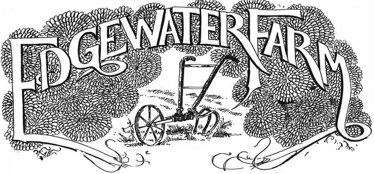That’s a catchy and cute picture. The question is this: What is the bigger picture? Well, one could view the photo as an interplanting of annuals in a tomato greenhouse. And that would be correct. But is there a purpose, other than the obvious ornamental aesthetic that marigolds and sweet allysum bring to any planting? Those of you who follow Edgewater Farm on the web or whom have shopped at our greenhouses and asked the pesticide questions of us will know that our insect control in our greenhouses is primarily achieved by the utilization of predatory or parasitic insects. Thus a true distinction between good bugs and bad bugs actually exists. This means we purchase and release bugs that will actually parasitize or eat the bad bugs. They are the good guys. Who are the bad bugs? There are many, but traditionally in new England greenhouses the Axis of Evil is comprised of 4 main bug species, and they are aphids, thrips, whiteflies and spider mites. If you are looking for a lesson in entomology and the taxonomy of insects you should start looking elsewhere other than my blog. Take my word for it. When the spring sun gets longer, the days warm up, the reproductive juices in these critters starts to flow. And one thing that insects can do is reproduce. In large numbers. Very quickly. And what fuels this lusty metabolic frenzy?The flowers and vegetables we had hoped to sell. Twenty five years ago- due in large part to research that was being done in Ontario and Vermont- we committed to trying to solve our insect pest problems in the greenhouse by introducing “beneficials”, a name for insects that attack pest populations through predation or parisitation. Everybody knows that ladybug and ladybird beetles view aphids as the “Quarter Pounder with Cheese” of the Insect Kingdom. Beetles are fast and efficient predators, and can decimate aphid populations that are able to reproduce at logarithmic rates in the spring. There is a beetle that decimates and cleans up white fly larvae. There are a host of tiny wasps that are predators of aphids and whiteflys as well. There are speedy little plant bugs that race around chewing up thrips in the flower sand leaves that are the above ground, and miniscule little soil born nematodes that devour thrips larvae growing in the soil.
So the main concept is to have enough good bugs in the greenhouse to balance out and reduce the population of bad guys in the greenhouse. After 25 years and a slow expensive slog of trial and error and research, we are 80% there. Sometimes we get caught. Things don’t go according to Nature’s or my plans, and we have to spray something when it all gets out of control in favor of the bad guys. Bio- control is expensive, and you have got to anticipate and lead an insect escalation in pest population like you have to lead the pitcher’s fastball. You have to make sure there are enough beneficials established before the problem is actually apparent. You watch for it, you get your bat off your shoulder and start your swing a little earlier. We locate “hot spots” of pests, and try to get a sufficient population of beneficials on board before it actually becomes a problem. Additionally, and making the process more problematic is they don’t carry bottles of ladybugs or encarsia formosa up at CVS or Walmart. People have to grow the good insects in captivity, sell them through a dealer network and get them to you in good shape, which means a good deal more than just “alive”. It takes a week lead time to order and have beneficials arrive on-farm. A weeks time. A lot of bad guy insect reproduction can happen in a week.
So, what is the deal with the marigolds and alyssum and how does it pertain to any of this? Insects are like humans in that they need a balanced diet. A beetle can survive a long time on aphids alone, just like I could live a while on quarter pounders with cheese. (I bet you didn’t think I would reuse that analogy, did you?) But something is missing out of both our diets. So improve my diet, I probably need some fruit or a salad. Or two. The parasitic insects like pollen and nectar. Nectar, its not just for honeybees anymore…. In the case of our alyssum, it feeds the good guy tiny parasitic wasps that are present in the tomato greenhouse, as well as the small bumble bee hive that I will purchase to pollinate my tomatoes. The pollen is enjoyed by good and bad alike, but by creating a habitat that fosters the good insects, we hopefully will offset any help we inadvertently have provided to the culprits as well. In short, insect control is achieved by moderating the environment. It is trickier and more expensive than buying a bottle of pesticide and spraying, but it is safer, and maybe more effective in the long run.
Furthermore, it provides an alternate strategy that makes it safer for me and suits the way I choose to farm. Out in the field, it works similarly, but because there is not enough research being done locally and the outdoor environment is much more difficult than the semi-closed environment of a greenhouse, there are a lot of gaps in the supply, production and knowledge regarding use of beneficial insects outdoors. I still have to resort to chemicals frequently when treating outdoor pests, but I foresee a time when the next generation here at the farm will be releasing beneficials on a large scale for pest problems in the field. In the next blog I will talk a bit more about pest control in the field and the industrywide changes that we are beginning to experience. Marigolds and alyssum. Not just another pretty face.

